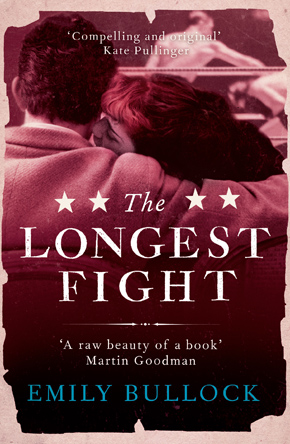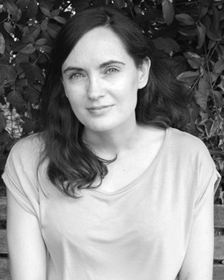Double English
by Emily Bullock
“A wonderfully compelling, atmospheric first novel.” Andrew Cowan
I was a slow learner; my primary school English teacher told me so and I almost believed her. She put me in remedial classes. I was taken off to another room away from the other children; but the support assistant let me sit and write stories, (I still have one of them, ‘Mrs Brambles’). After a few weeks the English teacher was made to take me back.
Thankfully I had plenty of great teachers after leaving that class; attending six schools, I met quite a few. At each new school I’d arrive before my records did and they’d put me in a low set, watching me like a petri dish to see if I’d bloom to the surface. Sometimes I did but I also learned to keep out of sight, becoming a master of ‘in-house’ truanting; hiding behind stacks of chairs, or walking down corridors with a folded piece of paper in my hand to make it look like I’d been sent on an errand. Nobody ever stopped me. But I always returned for English lessons; the words ‘double English’ still make me smile.
I don’t come from a family of readers or writers but they are great storytellers; ‘hoots’ would take place in which the sole activity was to laugh at old family stories. My novel, The Longest Fight, was inspired by my grandfather and his London childhood. Jimmy Bullock, the Tooting Tiger, started boxing as a boy, fought on air bases during the war, and after the war became a builder by day, a fighter by night. It now seems inevitable that I would choose to write about boxing but I avoided the topic for many years. The boxing hero is such an established archetype that as a writer I felt constrained by it. Then I met my partner, who also had a grandfather who was a boxer. Together we talked about knowing we had such aggression and strength in our families, and by some transference we felt it gave us something significant (strong legs, broad shoulders, a certain pugnaciousness). I decided to write about the impact of the sport on family dynamics and the role of women in the lives of these fighters.
In some ways all the characters I’ve ever written about are fighters: I never really know who they are, or how to write about them, until I test what they will and won’t do; pushing them into a story and seeing how they battle their way out. It’s a longwinded technique, involving lots of rewriting, and it isn’t one I’d promote to students.
Students’ creativity and dedication is a constant source of motivation. I know how difficult it can be to admit you want to write; not until I started a creative writing MA at UEA did I even say the words out loud – ‘I’m a writer.'”
I certainly knew the type of teacher I didn’t want to be when I met my first students as an associate lecturer at the Open University. I often think I learn as much from them as I hope they do from me. I led a workshop once at the Imperial War Museum based around an exhibit called Baghdad Car Bomb. Moved by the student responses I heard that day, I went on to write the short story ‘Human Terrain’. Students’ creativity and dedication is a constant source of motivation. I know how difficult it can be to admit you want to write; not until I started a creative writing MA at UEA did I even say the words out loud – “I’m a writer.”
I have never enjoyed being taught but I love to learn. Independent learning was what I enjoyed most about UEA, the space and the time to discover what I wanted to write; the chance to engage with other writers and listen to their feedback – a dialogue rather than monologue I’d always found school to be. But there was more to learn, there always will be.
In 2010 I started a Creative Writing PhD with the Open University, finishing last year. Reading so much, learning so much, I wanted to find ways to express this in fiction. I used short stories as a testing ground, for techniques or characters. Out of this came ‘My Girl’, another boxing story but this time about a female fighter and her mother. The story went on to win the Bristol Short Story Prize, and was broadcast on BBC Radio 4. It was an amazing feeling to know that people were reading and responding to my work. The anthology got sent out to literary agencies and I was approached by Fran Barrie at Johnson and Alcock. Fran left the agency but passed on my manuscript of The Longest Fight to her colleague Ed Wilson, who thankfully loved it and found it a great home with Myriad Editions.
Everything seemed to come together when writing The Longest Fight, even the years I spent working in film production proved useful. I returned to films to help with the dramatic presentation of fights in the story. I attempted to follow the advice of Walter Murch’s In The Blink of an Eye (a perspective on film editing); he makes a strong argument for cutting with the blink when he describes how:
“If you are in an actual fight, you will be blinking dozens of times a minute because you are thinking dozens of conflicting thoughts a minute – and so when you are watching a fight in a film, there should be dozens of cuts per minute.”
The main character in my novel, Jack Munday, isn’t a boxer but a boxing manager. Making him a boxing manager gave the story the outsider point of view that was needed; a man whose own fighting days are over but who still surrounds himself with fighters, whose success is tied to theirs. In the same way I needed to find the connection that would tie me to Jack, enable me to bring him to life. He’s a fictional character, far removed from myself by gender, era and personality, but I did understand his yearning to make it, his desire to prove everyone wrong.
I still take myself off to a room away from everyone else to sit and write. I try not to listen to the voices of doubt; and whenever I put just the right words, in just the right order, it feels as good as double English, it feels like a victory.
 Emily Bullock is a former winner of the Bristol Short Story Prize (2011) and the National Writers in Education Conference (NAWE) Short Story Competition (2013). Her memoir piece No One Plays Boxing was shortlisted for the Fish International Publishing Prize 2013 and her short story Zoom was longlisted for the Bath Short Story Prize 2014. Her debut novel The Longest Fight is published by Myriad Editions.
Emily Bullock is a former winner of the Bristol Short Story Prize (2011) and the National Writers in Education Conference (NAWE) Short Story Competition (2013). Her memoir piece No One Plays Boxing was shortlisted for the Fish International Publishing Prize 2013 and her short story Zoom was longlisted for the Bath Short Story Prize 2014. Her debut novel The Longest Fight is published by Myriad Editions.
Read more.
emilybullock.com
Author portrait © Robin Lindsey

